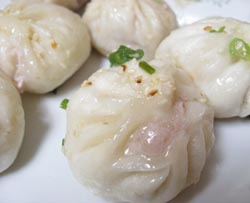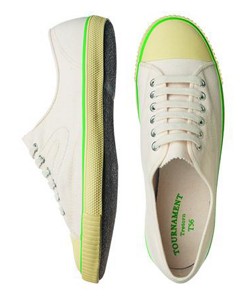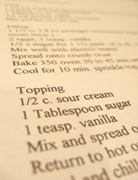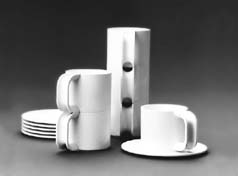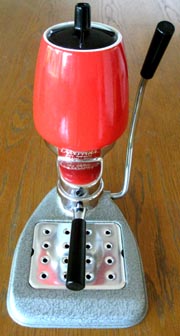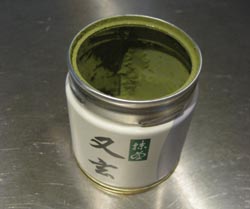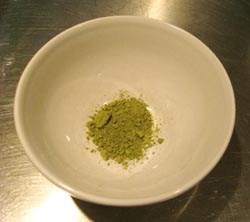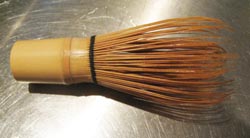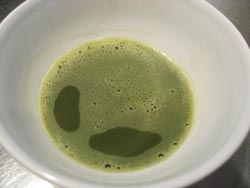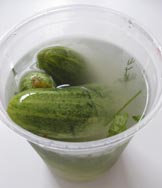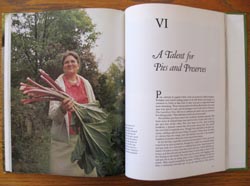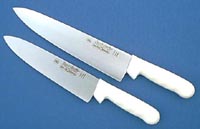what we love...
This is a delightful area where we will post short correspondence every few days on what we love ranging from products to recipes to who knows what, and updates on our new products. Feel free to stop back and see what we have added. We have intentionally built this page so no comments can be added to keep it clean and easy to maintain - so we can work more in the kitchen! Please note nothing here is an advertisement. |
|
October 27: Green Garbage
|
At the kitchen we make our products in we noticed this summer the sudden appearance of these green garbage bags. There were these signs posted that they could be put in the compost bin. We did a little research and discovered they are made from corn and are 100 percent biodegradable, and are provided through the San Francisco recycling program! We now use them in our home. They have this silky soft feel to them, are more elastic and stronger that the garbage bags we are all used to. They also make other biodegradable products, such as shopping bags, and lawn and leaf bags. We encourage all of you to seek out this product in your local grocery or supermarket, and if they don't sell it tell them to get it. |
|
October 19: Xiao Long Bao
|
These Shanghai-style dumplings are a real treat. They are filled with pork and seasonings and a little broth, so when you bite into them there is a warm rush of flavor that gushes into your mouth. If you can find a Shanghai restaurant that specializes in dumplings, please go. Of course some are better than others, but if you are a first timer you have nothing to lose. There are also pan fried pork and ginger dumplings, with nice crispy bottoms served with black vinegar and fresh ginger sliver dipping sauce, chunky homemade stir fried egg noodles with bits of pork and greens, tofu skins braised with shitake mushrooms and edamame, smoked tofu salad with cilantro and sesame oil, wontons tossed in a spicy chili oil...yes, stuff you can't get anywhere else. Just do a search on Shanghai dumplings and your city name and maybe you can find something. In the meantime, read about this type of cuisine: |
|
October 19: Tretorn Reborn
|
Back in the 1980s the Swedish sneaker company Tretorn made some of the most popular, coolest tennis shoes around. They came in white with the blue v logo. That was it. We've all forgotten about Tretorn until we were reminiscing and decided to do a search online and guess what? They are still in business and have expanded to more than one style of shoe, and also some cool clothes. We love bright green as a color and so the shoes above we definitely love and do wear. Check out their site where you can buy online. Lots of neat stuff you can't get buy anywhere in the U.S. |
|
October 14: Best Cheesecake Recipe
|
This is hands down the very best cheesecake recipe in the world. It is from an old family friend and dates back to the early 1960s. Whenever we make it, it lasts no more than 24-hours between the two of us. We eat it for breakfast, lunch and dinner. It is that good. Crust: 1 1/2 Cup of crushed graham crackers - use a food processor, then add 3 Tablespoons of melted butter, 1 Tablespoon of brown sugar, 1/2 Cup of ground walnuts, blend and pat into a pie pan. Filling: Mix two 8 oz packages of room temperature cream cheese with 2 eggs, 1 teaspoon of vanilla extract, and 3/4 cup of white cane sugar. Pour into pie crust, and bake in a preheated oven at 350 for 30-40 minutes until puffed. Cool for 10 minutes and sprinkle top lightly with cinnamon. Topping: Blend 1/2 cup of sour cream, 1 Tablespoon of white cane sugar, 1 teaspoon of vanilla extract and spread on top of filling. Return to hot oven for 5-10 minutes. Cool and chill and then add your choice of fruit topping - cherries in syrup, blueberries and strawberries with glaze etc. |
|
October 14: Best Serviceware
|
Massimo and Lella Vignelli, who comprise the company Vignelli Associates, are perhaps one of the most important product/graphic design teams of the past century. Ever been on the NYC subway? Well, the signage and maps were created by them. They've done everything from Benneton to IBM to Bloomingdales. In the 1960s they created a line of melamine plates, bowls, cups, saucers and pitchers etc. called Heller that we use every day. We are lucky to have originals that were made in Italy. The picture above shows the very rare espresso cups and saucers (we have orange and white) that are the supreme statement of beauty. You could buy sets that were modular and when assembled looked like a futuristic cityscape. You can find them on ebay but be careful, some are knock offs and are of an inferior melamine that cracks - plus they are slightly larger in size and thus do not stack with the originals. Design Within Reach is selling sets these days to avoid buying the risky old stuff. The best thing about melamine is it is light weight and retains heat far better than the hard, loud porcelain and ceramic most people use. |
|
October 10: Good Water
|
One of the best things about our home kitchen is the instant hot/cold filtered water we have. Making tea is a breeze, and for cooking, having filtered hot/cold water is very helpful. And of course just for drinking water this is the best. We have a lead-free faucet and Everhot water boiler by Water, Inc. The boiler fits under the counter and the faucet can be mounted anywhere. We have a little sink built into our countertop near our cooktop. If you are redoing a kitchen, this is very easy to set up and a small bar sink works fine or you can have one custom fabricated like ours by any restaurant stainless steel fabrication shop. For the water filter we use one by Everpure - one for the little sink we just mentioned and one for the ice maker of our refrigerator. Again, adding a good quality water filter to your ice maker not only insures healthy ice, but it tastes better too. The Everpure filters last about a year, and for around $130 they are worth their weight in gold. Not only will you get very good, clean water, but if you drink water out of plastic bottles, be aware that there are health risks associated with this type of plastic! |
|
October 10: La Peppina
|
The La Peppina espresso maker is a completely unique machine that was made in Italy by the Fear company from the early 1960s into the early 1970s. The model we have is the very first they made. Later models have a steamer that is inserted into the top of the boiler tank (the red part on our machine). These machines make incredible espresso. Their design is fascinating. Your pour water into the boiler on top and it heats to a boil. You then turn the power off and pull the lever down all the way and then raise it about two inches, and push it down. You do this pumping of only 1-2 inches at the lowest angle of the lever until small drops of espresso start to drip into your cup. Sometimes you have to pump a long time! Then you push the handle all the way up to the top. This machine has a very strong spring that will automatically raise the lever once you let go, but we find a little extra help will create more pressure and better crema. Ideally, the lever should move from bottom setting to top in about 10 seconds - so play with your grind thickness and quantity to get this rate. These machines can be found on ebay, and there are some gaskets you can also buy on ebay to replace worn out ones. Good sites that discuss these machines are coffeegeek.com and home-barista.com. Along with our Olympia Cremina (see post below) the La Peppina is our favorite espresso maker. There are many variables that affect the quality of espresso, aside from machines, your technique, and the beans used (see below). If you get an espresso machine you need to get a high quality burr grinder. Don't get the stuff sold at Williams Sonoma or Sur La Table. That stuff is pretty crappy. Get either a doserless Rancilio Rocky, a Mazzer Mini or a Mahlkonig K 30 ES. These machines will last a lifetime and are the best. Most American companies over roast their beans so they are almost burnt and very oily. Think Stabucks and Peets. Good quality Italian-style beans are of a lighter roast, are almost dry and have better flavor. We think the over roasting of American beans, along with the exclusion of robusta beans (found in most Italian blends) is due to Americans' love of adding all kinds of sugar and milk and flavorings (um pumpkin???) to their coffee and therefore the need for a stronger flavor. However, lighter roasts exhibit more of the flavor of the beans. |
|
October 10: Matcha
|
We love tea and have all kinds at home but one special tea that few people know about is matcha. This type of tea is very traditional in Japan and is closely linked to the tea ceremony. The tea is super high quality and made from young buds from the top of the plant that are dried and ground to a fine powder. Unlike the tea most people drink, this is made so that you actually consume the tea leaves in powder form, so you get the utmost in nutrients. While there are all kinds of customs on the preparation in the tea ceremony, we just make it to drink. So here is a rundown that is stripped of all the cultural and ceremonial elements. Eric learned all about how to prepare this from - how shall we say this delicately - his personal assistant or female butler - at an ultra exclusive, very traditional ryokan in Kanazawa he stayed at. No matter what time of day he appeared in his traditional sukiya house, she magically appeared to prepare matcha and serve wagashi. If you are ever in Japan, you must stay here since all guests have their own private homes and they are famous for their meals, which come at a discount if you are a guest. What is this magical place? Kincha Ryou. In fact the meals he had here rank among the best ever. Similar to kaiseki, but regionally different, and seated in hundreds of years tradtion, this is a place sought out primarily by Japanese politicians who can afford the best money can buy. Few westerns have stayed here, but Eric was told the only other American who had stayed in his cottage was Henry Kissinger. First find high quality matcha at a Japanese market. If there is no English on the container that is a good sign. The color of the powder must be bright green. Inferior quality is darker and the powder is more grainy. Add about a teaspoon of the powder into a small bowl.
Then you add around 1/4 to 1/3 cup of hot, but not boiling water to the powder. Using a bamboo tea whisk called a chasen...
you whisk the tea using zig zag motions side to side until the powder is blended into the water and the top is foamy. In the picture below the foam subsided a bit...it normally is all foam on top.
Then you place the bowl on your left palm and using your right hand, turn the bowl three times clockwise, this is the only custom we follow since it is basic good manners, and drink. Good matcha has a perfumy, sweet but earthy taste this is totally unique. Matcha is normally served with small sweets made from pounded rice called wagashi. If you live in a large city you might find some places that make these traditional sweets that are very yummy and healthy. This is a dying art form since younger Japanese Americans don't want to take over the family business. Two places in SF that used to make it fresh closed when the people retired. |
|
October 9: From Russia With Love
|
A friend of ours who is Ukrainian turned us onto a whole bunch of Russian/Ukrainian foods. Our favorites are the salty pickles and whortleberry juice. The pickles are made with just salt, water and spices (including garlic, dill and black currant leaves) and must ferment. Apparently they are eaten while drinking vodka, and ironically if you have a hangover, drinking the brine is a cure! We tried making them once with our friend but it takes too long and we are impatient so we just buy them. They are the best pickles we have ever eaten. They are an essential ingredient in Solianka, a really delicious beef-stock-based tomato soup you must try to make that has sausage, lemons, pickles in it. Normally, the pickles we buy come packed in plastic deli containers like the photo above, but when we went a few days ago they were in big buckets and it was self serve. The name on the buckets was Ba-Tampte, out of Brooklyn. Their phone number is (718) 251-2100. Why not call and find out the closest retailer that sells them? The whortleberry tastes sort of like a lingonberry, if you know what that tastes like. If not, a more mild cranberry. You can only get this juice at Russian markets. This brand is Wonder Berry and is imported from Russia. Good excuse to find a local Russian market. Also, if you like sausages, most Russian markets have tons of them. The market we go to in SF has easily about 15 refrigerators full of them - hundreds of varieties! |
|
In 1968 Time Life published their first cookbook in what would become a long series of books. It was called "The Cooking of Provincial France." The author was the witty M.F.K Fisher and Julia Child was a consultant. Somewhere we read an article about this series and how the very first version released in France had all kinds of horrible things to say about Americans as a result of either the translator or the French chef who helped with the recipes. That version apparently was re-written with the help of Fisher and Child, and we guess is the one we have and that is floating around. Not sure where we read the article. Was it in Vanity Fair? Hmmm... Anyhow, Time Life went on to publish versions on all kinds or regional cuisines. There were ones on Russian cooking, Italian cooking, New England cooking (pictured above - click it to see larger image) etc. What we love about these are the step back into time they allow. Most of the books were published in the late 1960s and early 1970s. Some great photography is in them like the photo above, and the writing is excellent. You can just sit down and read away. The recipes are pretty good as well. You can find versions in thrift stores for about a dollar or two, or buy entire sets on Ebay. Note. All hard cover books had spiral bound soft back versions that came with them and had the bulk of recipes. It is hard to find both together. There is also a very cool, oversized Picture Cookbook they released in 1959 worth finding. |
|
October 5: The Ultimate Blade
|
There is a big divide between what professional cooks use and what is found in high-end, home kitchens. For example, most people use stainless steel cookware like All Clad at home, but almost all commercial food facilities and restaurants use low quality, cheap aluminum. This is a dirty little secret no one talks about. Next time you go to some fancy restaurant, keep in mind your food most likely was cooked in cheap aluminum. We hate aluminum and will never use it. Everything we make at home or in our facility is in stainless steel since it provides a flavor-neutral environment, unlike aluminum. Then there is kitchen knives. Most people have those fancy, expensive German brands, as do we at home. But in commercial kitchens most people use Dexter-Russell Sani-Safe knives. We purchased some to use in our facility and are sold. They hold their edge longer and can be made much sharper. The reason? The blade is composed of a higher amount of carbon and less stainless steel. While they say these blades are stainless, the higher carbon content will get some stains due to the lower amount of stainless steel. All we care about is a sharp blade and a few stains mean nothing. Do yourself a favor and get some of these knives - Amazon.com sells them among other online shops. They are dirt cheap and blow the Germans out of the water. And there are literally hundreds of different knives in this line. Who knew there were so many different styles of oyster knife and that they are named after different cities? These knives are also very industrial chic. So you see, stainless steel is a good thing for cookware, but too much in a knife can be a disadvantage. |


